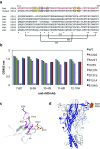Evidence for detection of rat P2X4 receptor expressed on cells by generating monoclonal antibodies recognizing the native structure
- PMID: 30684150
- PMCID: PMC6439026
- DOI: 10.1007/s11302-019-09646-5
Evidence for detection of rat P2X4 receptor expressed on cells by generating monoclonal antibodies recognizing the native structure
Abstract
P2X purinergic receptors are ATP-driven ionic channels expressed as trimers and showing various functions. A subtype, the P2X4 receptor present on microglial cells is highly involved in neuropathic pain. In this study, in order to prepare antibodies recognizing the native structure of rat P2X4 (rP2X4) receptor, we immunized mice with rP2X4's head domain (rHD, Gln111-Val167), which possesses an intact structure stabilized by S-S bond formation (Igawa and Abe et al. FEBS Lett. 2015), as an antigen. We generated five monoclonal antibodies with the ability to recognize the native structure of its head domain, stabilized by S-S bond formation. Site-directed mutagenesis revealed that Asn127 and Asp131 of the rHD, in which combination of these amino acid residues is only conserved in P2X4 receptor among P2X family, were closely involved in the interaction between rHD and these antibodies. We also demonstrated the antibodies obtained here could detect rP2X4 receptor expressed in 1321N1 human astrocytoma cells.
Keywords: FSEC; Monoclonal antibody; Neuropathic pain; P2X4 receptor.
Conflict of interest statement
Conflicts of interest
Tatsuhiro Igawa declares that he has no conflict of interest.
Shuhei Kishikawa declares that he has no conflict of interest.
Yoshito Abe declares that he has no conflict of interest.
Tomohiro Yamashita declares that he has no conflict of interest.
Saki Nagai declares that she has no conflict of interest.
Mitsunori Shiroishi declares that he has no conflict of interest.
Chinatsu Shinozaki declares that he has no conflict of interest.
Hiroyuki Tanaka declares that he has no conflict of interest.
Hidetoshi Tozaki-Saitoh declares that he has no conflict of interest.
Makoto Tsuda declares that he has no conflict of interest.
Kazuhide Inoue declares that he has no conflict of interest.
Tadashi Ueda declares that he has no conflict of interest.
Ethical approval
All animal experiments were conducted according to the relevant national and international guidelines in the Act on Welfare and Management of Animals (Ministry of Environment of Japan) and the Regulation of Laboratory Animals (Kyushu University), and under the protocols approved by the Institutional Animal Care and Use Committee review panels at Kyushu University.
Figures





Similar articles
-
Analysis of binding residues in monoclonal antibody with high affinity for the head domain of the rat P2X4 receptor.J Biochem. 2021 Apr 29;169(4):491-496. doi: 10.1093/jb/mvaa124. J Biochem. 2021. PMID: 33169129
-
Solution structure of the rat P2X4 receptor head domain involved in inhibitory metal binding.FEBS Lett. 2015 Mar 12;589(6):680-6. doi: 10.1016/j.febslet.2015.01.034. Epub 2015 Feb 4. FEBS Lett. 2015. PMID: 25662851
-
Preparation and characterization of a monoclonal antibody against the refolded and functional extracellular domain of rat P2X4 receptor.J Biochem. 2013 Mar;153(3):275-82. doi: 10.1093/jb/mvs143. Epub 2012 Dec 7. J Biochem. 2013. PMID: 23220420
-
P2X4 receptors expressed on microglial cells in post-ischemic inflammation of brain ischemic injury.Neurochem Int. 2014 Feb;67:9-13. doi: 10.1016/j.neuint.2014.01.011. Epub 2014 Jan 31. Neurochem Int. 2014. PMID: 24486458 Review.
-
[Green Pharma: A New Strategy for Drug Discovery in Academia by Targeting Glial Cells and ATP Receptors].Yakugaku Zasshi. 2018;138(8):1027-1031. doi: 10.1248/yakushi.17-00211-1. Yakugaku Zasshi. 2018. PMID: 30068843 Review. Japanese.
Cited by
-
The Role of ATP Receptors in Pain Signaling.Neurochem Res. 2022 Sep;47(9):2454-2468. doi: 10.1007/s11064-021-03516-6. Epub 2022 Jan 30. Neurochem Res. 2022. PMID: 35094248 Review.
-
Microglia in Neuropathic Pain.Adv Neurobiol. 2024;37:399-403. doi: 10.1007/978-3-031-55529-9_22. Adv Neurobiol. 2024. PMID: 39207704 Review.
-
Human Peripheral Blood Eosinophils Express High Levels of the Purinergic Receptor P2X4.Front Immunol. 2019 Sep 6;10:2074. doi: 10.3389/fimmu.2019.02074. eCollection 2019. Front Immunol. 2019. PMID: 31552031 Free PMC article.
-
Improvement of the affinity of an anti-rat P2X4 receptor antibody by introducing electrostatic interactions.Sci Rep. 2022 Jan 7;12(1):131. doi: 10.1038/s41598-021-03784-w. Sci Rep. 2022. PMID: 34996944 Free PMC article.
References
Publication types
MeSH terms
Substances
Grants and funding
LinkOut - more resources
Full Text Sources

